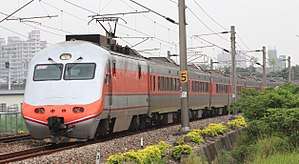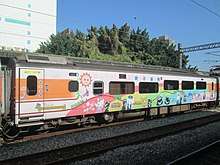E1000 series
The E1000, commonly known as the PP Tze-chiang,[2][3] is a series of electric push-pull trains used by the Taiwan Railways Administration (TRA), operated as part of the Tze-chiang limited express service. The locomotives were built by Union Carriage & Wagon and GEC-Alsthom, while the passenger cars were built by Hyundai Precision & Industries.[4]
| Taiwan Railway E1000 series | |
|---|---|
 | |
| In service | 1996–present |
| Built at | Locomotive: Union Carriage & Wagon, GEC-Alsthom Passenger car: Hyundai Precision & Industries |
| Constructed | 1996–1997 |
| Number built | 64 locomotives |
| Number in service | 64 locomotives (as of 2015)[1] |
| Specifications | |
| Train length | 17,211 mm (56 ft 5.6 in) |
| Width | 2,885 mm (9 ft 5.6 in) |
| Height | 4,265 mm (13 ft 11.9 in) |
| Maximum speed | 130 km/h |
| Weight | 60 t |
| Axle load | 15 t |
| Power output | 2,336 kW (3,133 hp) |
| Tractive effort | 16,735 kgf |
History
The E1000 series was built to replace the EMU100 series. In 1994, the TRA came to an agreement with Hyundai Precision & Industries to build 64 locomotives and 400 passenger cars for $7.2 billion NTD.[5] Hyundai manufactured the passenger cars, while the locomotives were built by Union Carriage & Wagon and GEC-Alsthom. The first arrived in April 1996 and passenger services commenced in September of the same year.[4]
At the time of the units' arrival, trains were popular since they were first to use a streamlined design, contrasting with the boxy design of its predecessor.[6] However, the TRA soon reported that the trains suffered from frequent traction motor failures and insufficient power delivery due to poor maintenance, oftentimes requiring a third locomotive to be attached to the rear as a backup. Due to the poor quality of stainless-steel painting processes at the time of production, the coaches were also not painted, but rather had stickers applied, which began to fade, mottle, and peel after exposure to weather and sunshine in service. The multitude of problems plaguing the class earned them the derisive nickname "Beggar Gang Train" among enthusiasts and the press. [3][7] The poor state of repair, combined with paying-off of the maintenance contract's performance bond following Hyundai's merger with Rotem, and subsequent withdrawal of support staff from Taiwan in 2003, prompted TRA to sue the company in 2005 for $1.7 billion NTD in damages;[8] however, the lawsuit never came to fruition. Nevertheless, in response, Minister of Transportation and Communications Lin Ling-san banned South Korean companies from participating in future transportation bids until problems with the E1000 and other South Korean-produced equipment are resolved.[5] The two reached an agreement of $300 million NTD in 2018. [8][9]
By 2010, remedial work to the locomotives done under supervision of Alstom had improved reliability, and the carriages began undergoing repainting to resolve the paint issues. Despite the problems, however, the E1000 series has been a regular fixture within the Tze-chiang family since entry into service owing to the large class size, and with the electrification of railroads, the E1000 has begun to replace DMU on East Coast Tze-chiang services.[4] In a report from 2015, the TRA listed the E1000 series as one of the trains to be replaced in the near future as it approaches its 30-year lifespan.[1]
Features

The E1000 series is configured in a push-pull arrangement, with a locomotive at each end of the train. Electricity is delivered via overhead lines, and each locomotive features four motors for a combined 2,336 kilowatts (3,133 hp) per locomotive. The trains are designed to run in 12-15 passenger car configurations. The bogies were supplied by Krauss-Maffei, while the braking system are supplied by Knorr-Bremse.[4]
Dining cars and reconfiguration
Originally, the E1000 series featured 32 dining cars. When the TRA phased out on-board dining, the cars were briefly used as baggage cars. Currently, 11 of the dining cars are reconfigured as handicapped-accessible passenger cars, while 20 of the cars are reconfigured as "family cars', which feature a different seat layout, a children's play area, and breastfeeding rooms.[10][11]
See also
References
- "臺鐵整體購置及汰換車輛計畫(104~113年)" (in Chinese). Taiwan Railways Administration. 2015. p. 12. Retrieved 30 April 2020.
- 王思慧 (15 October 2018). "台鐵車種如聯合國 將逐步統一降低成本" (in Chinese). China Times. Retrieved 30 April 2020.
- 楊宜中 (3 July 2005). "PP車問題多 駛來膽戰心驚" (in Chinese). Liberty Times. Retrieved 30 April 2020.
- 鐵道情報91、92期 (in Chinese). Train Collection: 鐵道情報. Retrieved 30 April 2020.
- 謝武雄 (13 April 2018). "《桃園》韓車爛攤一堆 台鐵拒買10年" (in Chinese). Liberty Times. Retrieved 30 April 2020.
- "台鐵 VS 高鐵 尬速度 內湖→台中 拼輸贏". 車訊網 (in Chinese). 2 February 2007. Retrieved 30 April 2020.
- 鄭瑋奇 (30 November 2018). "台鐵190.8億元機車採購案 今首次開標就流標" (in Chinese). Liberty Times. Retrieved 30 April 2020.
- 李姿慧 (13 October 2018). "254億元通勤電聯車採購案有弊?台鐵:子虛烏有" (in Chinese). Apple Daily. Retrieved 30 April 2020.
- 賴佩璇 (20 September 2019). "批政府介入台鐵千億購車弊案 吳子嘉獲不起訴" (in Chinese). United Daily News. Retrieved 30 April 2020.
- "親子車廂" (in Chinese). Taiwan Railways Administration. 1 March 2020. Retrieved 30 April 2020.
- 鄭瑋奇 (10 July 2018). "台鐵親子車廂7/27起增班 違規佔用可加收1/2票價" (in Chinese). Liberty Times. Retrieved 30 April 2020.
External links
![]()